One of the neatest aspects of archaeology is how one small, seemingly pedestrian artifact can have a massive impact on our understanding of the past. Take a single olive pit, for example. It would be an entirely unremarkable find in southern Europe, no matter how old the pit was, and almost as unremarkable a find in Roman Britain. An olive pit from first century B.C. Britain, on the other hand, is a revelation.
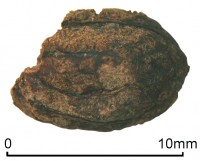 Archaeologists from the University of Reading excavating the site of Silchester in Hampshire found a single olive pit in an Iron Age well. The layer it was found in has been firmly dated to before 43 A.D., the year of the Roman invasion of Britain under the Emperor Claudius, which means that the olive made its way to Iron Age England before the Romans did. Celery and coriander seeds were also found in the same well. Taken together they indicate that Britons were enjoying Mediterranean cuisine long before they had a direct link to it.
Archaeologists from the University of Reading excavating the site of Silchester in Hampshire found a single olive pit in an Iron Age well. The layer it was found in has been firmly dated to before 43 A.D., the year of the Roman invasion of Britain under the Emperor Claudius, which means that the olive made its way to Iron Age England before the Romans did. Celery and coriander seeds were also found in the same well. Taken together they indicate that Britons were enjoying Mediterranean cuisine long before they had a direct link to it.
Professor Michael Fulford, from the University of Reading’s Department of Archaeology, said: “These plant foods were all cultivated in the Mediterranean region and literary evidence shows they were part of Roman cuisine. Whilst the import of olive oil and wine during the Late Iron Age is evidenced at Silchester and elsewhere throughout southern Britain, we were unaware that olive fruits and seasonings were also being imported – until now.
“Topics such as global food trade, food security and self-sufficiency may seem like issues only for the present day, but this unique discovery shows just how sophisticated Britain’s trade in food and global links were, even before the Romans colonised in the first century AD.
“We take these culinary treats for granted but over 2000 years ago trade in these foodstuffs would have been essential, at least for the wealthy tribal aristocracy of Iron Age Britain. A journey to Britain from the Med would have taken several weeks, either by sea around the coasts of Spain, Portugal and France, or overland through France. This is the first olive from Iron Age Britain!”
The olive pit shows signs of charring, which may have helped it survive the next two millennia. Professor Fulford hopes they will find more olive pits indicative of a wider trade in luxury Mediterranean foods, but they could easily have rotted away.
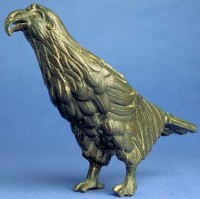 Silchester has been a source of fascinating discoveries since the Victorian era. The site of an important Roman-era town called Calleva Atrebatum, Silchester exploded on the archaeological scene in 1866 when Reverend J.G. Joyce found a cast bronze eagle in the forum basilica between two burnt layers. He thought its exquisite detail marked it as the imperial standard of a Roman legion which had been removed from its staff and hidden in the rafters of the basilica during an attack on the city. When the basilica was burned down, the eagle went down with it. It was this discovery and Joyce’s theory about it that inspired Rosemary Sutcliff’s The Eagle of the Ninth and ever so many sub-par movies.
Silchester has been a source of fascinating discoveries since the Victorian era. The site of an important Roman-era town called Calleva Atrebatum, Silchester exploded on the archaeological scene in 1866 when Reverend J.G. Joyce found a cast bronze eagle in the forum basilica between two burnt layers. He thought its exquisite detail marked it as the imperial standard of a Roman legion which had been removed from its staff and hidden in the rafters of the basilica during an attack on the city. When the basilica was burned down, the eagle went down with it. It was this discovery and Joyce’s theory about it that inspired Rosemary Sutcliff’s The Eagle of the Ninth and ever so many sub-par movies.
Professor Fulford thinks Joyce’s interpretation of the archaeological data was incorrect. According to his analysis, the two burnt layers date to the time of the basilica’s construction (early second century A.D.) and from smithing fires once the building was in use. He thinks the eagle dates to the early first century A.D. and was once part of a larger statue, an attribute of the god Jupiter or a Roman emperor. A hundred years later, the eagle, now missing its wings and its deity, was incorporated into the foundations of the basilica as a sacrifice or for good luck.
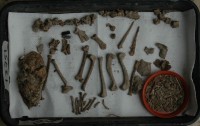 Speaking of sacrifices, an unusual number of complete dog skeletons have been found buried in Silchester since Fulford’s University of Reading teams began excavating in 1997. They appear to have been buried deliberately over a span of two centuries, sometimes very carefully positioned. Three of them are of two dogs buried together, one of a dog buried with a human infant, and one of a dog standing up. Earth was packed in around his feet and legs to ensure he remained in that posture in the grave. We don’t know if they were sacrificed or buried after natural death.
Speaking of sacrifices, an unusual number of complete dog skeletons have been found buried in Silchester since Fulford’s University of Reading teams began excavating in 1997. They appear to have been buried deliberately over a span of two centuries, sometimes very carefully positioned. Three of them are of two dogs buried together, one of a dog buried with a human infant, and one of a dog standing up. Earth was packed in around his feet and legs to ensure he remained in that posture in the grave. We don’t know if they were sacrificed or buried after natural death.
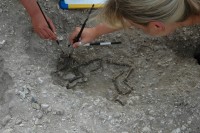 Last year they discovered yet another dog burial, this one of a tiny toy dog only 11 inches (29 centimeters) high at the shoulder. It was not a puppy but a full-grown lapdog, likely another luxury import from the continent. It was discovered buried in a natural resting posture in the foundations of a large Iron Age house, a house that is at least 164 feet long (50 meters) and may turn out to be the largest Iron Age building ever discovered in Britain. The owner must have been a highly prominent citizen, possibly the chief. Again, archaeologists can’t tell if the dog was killed deliberately as a sacrifice or it just died in time to be buried in the foundations of the house.
Last year they discovered yet another dog burial, this one of a tiny toy dog only 11 inches (29 centimeters) high at the shoulder. It was not a puppy but a full-grown lapdog, likely another luxury import from the continent. It was discovered buried in a natural resting posture in the foundations of a large Iron Age house, a house that is at least 164 feet long (50 meters) and may turn out to be the largest Iron Age building ever discovered in Britain. The owner must have been a highly prominent citizen, possibly the chief. Again, archaeologists can’t tell if the dog was killed deliberately as a sacrifice or it just died in time to be buried in the foundations of the house.
Another discovery in keeping with the dog theme but with a far more entertaining spin is a folding knife or shaving razor that has an elephant ivory handle carved in the shape of two dogs having sex. It was made in the second century and again was a continental import, possibly from Italy, France or Germany. It is a unique find in the Roman world.
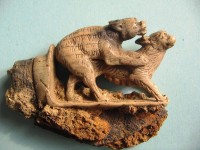
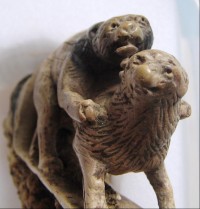
There’s tons of information about the history of Silchester and excavations current and historic on the University of Reading’s website. The excavation blog is excellent. There are many pictures of the Somme-style mud pits the poor archaeologists have to deal with thanks to the crazy rain England has been experiencing this summer. If you’re in the neighborhood, they welcome visitors during the excavation season.
I take your point but still note that your headline is Onion worthy.
Wow, it really is quite soggy there!
They had said in an article I read that the wells they’ve been excavating were (ironically) the driest parts of the site lately because they at least have pumps going in them to carry away the water.